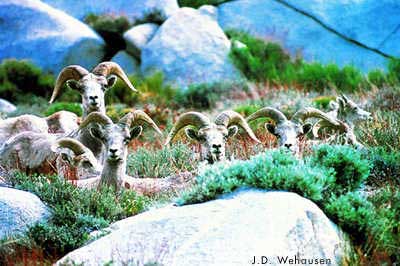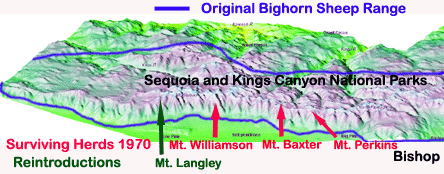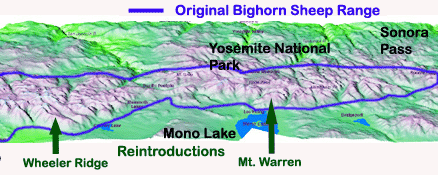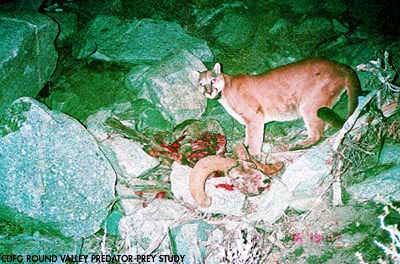Sierra Nature Notes, Volume 2, March 2003
Sierra
Nevada Bighorn Sheep: a Brief History
by John Wehausen
President, Sierra Nevada Bighorn Sheep Foundation
 |
Alert
and elusive: Sierra Nevada bighorn sheep. |
A Perfect
Strength and Beauty
Sierra Nevada bighorn sheep are awe-inspiring inhabitants of a magnificent
mountain range and one of the great symbols of wilderness, reminding us of
an era when their mountain realm was considerably less altered by modern humans.
These wild sheep are a unique form (subspecies) of bighorn that apparently
evolved as such in only the eastern portion of the southern and central Sierra
Nevada of California, and thus belong to a select group of endemic plants
and animals that call those mountains home. The great naturalist John Muir
took a special interest in these sheep and wrote of them:
Possessed of keen sight and scent, and strong limbs, he dwells secure amid the loftiest summits, leaping unscathed from crag to crag, up and down the fronts of giddy precipices, crossing foaming torrents and slopes of frozen snow, exposed to the wildest storms, yet maintaining a brave, warm life, and developing from generation to generation in perfect strength and beauty.
Were granite to come to life, it would undoubtedly look like a bighorn sheep, so perfectly do they blend into that habitat. Though sightings today are rare, these sheep can occasionally be seen on steep rocky areas along the Sierra crest by sharp-eyed hikers with the patience or luck to find these rocks with legs. Hikers often pass within a hundred feet of a small band without seeing them. Bighorn sheep use the rocky, steep terrain for safety from predators – bedding down on ledges and steep slopes at night. When feeding, they remain near the more rugged terrain and cliffs should they need to escape a predator. The primary sense used to detect predators is very keen eyesight and their preferred habitat is visually very open where predators can be detected at a long distances.
In summer, Sierra bighorn are found along the rugged crest of the range between 10,000 and 14,000 feet, mostly in Sequoia and Kings Canyon National Parks and adjacent National Forest lands. Although they are capable of remaining at those high elevations in winter, they prefer to descend to the base of the eastern escarpment to utilize better suited patches of habitat where environmental conditions are more favorable and more nutritious food is available.
Before the coming of Euro-Americans, these sheep once occurred as scattered herds along the crest of the Sierra Nevada from the Sonora Pass region to Olancha Peak, as well as the Great Western Divide. Hunting and fatal livestock diseases rapidly reduced their numbers, eliminating entire herds beginning in the 1860s. These herd losses continued well into the twentieth century. Fortunately, three herds survived this onslaught, located in regions around Mount Williamson, Mount Baxter, and Mount Perkins in remote areas of the Sierra crest.
 |
 |
| Current
populations and historic range of Sierra bighorn sheep: southern Sierra
(top); central Sierra (bottom). (click to enlarge to
full map). Adapted from map produced by Gordon Ye, UC Berkeley AEGIS Laboratory, All rights reserved. |
Also fortunate, the Mount Baxter and Sawmill Canyon herds had grown to sufficient sizes in the 1970s to allowed them to be used as sources of sheep to reestablish extirpated herds. A successful reintroduction program began in 1977. Between 1979 and 1988 sheep were periodically captured and moved to three areas: Wheeler Ridge, Mount Langley, and Mount Warren. Initially these newly established herds increased; but during the 1980s ecosystem-level changes occurred that ultimately caused population declines across the range and forced the suspension of the program. During that decade, mountain lion predation on these sheep increased sharply on winter ranges and the sheep began avoiding the use of those more favorable low elevation winter ranges at the base of the eastern escarpment.
Endangered
Listing Sought
This change in winter habitat selection ultimately led to significant declines
in herd sizes, reversing the initial increasing trend associated with the
restoration program. From the late 1970s to the mid 1980s the total number
of bighorn sheep in the Sierra Nevada increased from 250 to about 310, but
then declined to about 100 by 1995. Field data indicated that only about 100
adults remained in 1998. These numbers were divided among 7 herds, some of
which were even further subdivided into independent groups of females. Every
group of females reached a reproductive base low point of fewer than 10 females
and in at least 5 there were fewer than 5 females. The smallest dropped as
low as a single remaining female. With such low numbers, every herd was vulnerable
to disappearing.
This dangerous situation was brought to the attention of appropriate state and federal agencies early in 1999 through petitions, and this initiated a series of important conservation actions that year. First, the California Fish and Game Commission classified these sheep as a California endangered species. A month later the U.S. Fish and Wildlife Service classified them as a federal endangered species on an emergency basis and bestowed full endangered species status in January 2000.
Federal endangered status was needed partly because the California Department of Fish and Game (DFG) lost its ability to protect threatened and endangered species from mountain lion predation when California voters passed the Wildlife Protection Act in 1990. The federal Endangered Species Act was needed because that federal statute supersedes state law. Later in 1999 the California legislature responded by altering the Wildlife Protection Act, allowing DFG to remove lions that posed an imminent threat to bighorn sheep populations, and this was signed into law by the governor. Because of provisions in the Wildlife Protection Act, this required a four-fifths vote of the California Legislature – a level of support that few bills receive.
Federal endangered species status also was essential to enable local federal land management agencies to largely eliminate the threat of a catastrophic die-off of bighorn sheep that would follow contact with domestic sheep. Stray domestic sheep that escaped nearby allotments on federal lands had been documented in bighorn sheep habitat on multiple occasions. Thus, it was only a matter of time until a catastrophic contact between these two forms of sheep would occur. Healthy domestic sheep carry strains of bacteria that cause fatal pneumonia in bighorn sheep.
The final remarkable
event in 1999 involved legislative financial support for Sierra Nevada bighorn
sheep. As a response to the media attention Sierra bighorn received that year,
the legislature agreed to fund a 5-year initial recovery program for these
sheep. One of the most difficult issues of this recovery program for the responsible
state and federal agencies is predator management. A major spike in the mountain
lion population occurred through the 1980s when winter range avoidance by
the bighorn sheep began, but the local lion population has seen the opposite
trend through the 1990s. As is typically the case in resource management,
a remedy in the form of predator control was needed long ago – 10-20
years ago at a time when its need was not fully understood, nor was there
much of a penchant to engage in such. Nevertheless, agency personnel now charged
with protecting these bighorn sheep accept that some predator control may
still be necessary to help some herds gain sufficient numbers. However, it
is also recognized that too much such control may create a perturbation that
cascades through the ecosystem and leads to a new problem in the future. Finding
the best solution to this issue is not simple and responsible agencies continue
to grapple with the problem. The solution will evolve as more is learned about
this ecosystem.
 |
| Mountain Lion in the Sierra feeding on a Bighorn Sheep. |
Finding the
Balance
The California Department of Fish and Game is currently funding two teams
of professional trackers. These trackers determine when lions or other predators
pose a threat to bighorn sheep. If so, the trackers remove them or attempt
to chase them away. More importantly, a program to radio-collar all lions
near each bighorn sheep herd is now under way. This program will provide critical
information about the patterns of lions relative to bighorn sheep ranges to
determine which lions are more of a threat and when they are a threat. It
is hoped that this approach will minimize the number of lions that have to
be killed to protect bighorn sheep.
The good news is that after about a decade of decline, overall numbers of
bighorn sheep in the Sierra Nevada have been increasing since 1995, despite
further declines in one herd. Perhaps more important have been the particularly
rapid increases seen in just the past few years that have lead to a total
population of about 250 sheep at the end of 2001. That is the same number
of sheep that existed in 1978 just prior to the beginning of the reintroduction
program. The difference is that they are now distributed among more herds
and the largest now (Wheeler Ridge) is the first that was reintroduced.
Despite all the good news, the little herds of sheep immediately east of Yosemite National Park that resulted from sheep moved there in 1986 and 1988 continue to teeter on the edge of extirpation. The bighorn sheep in this area grew in numbers only after mountain lion control was carried out during 1988-90, and then increased to become the largest herd in the Sierra Nevada in the early 1990s. Following the cessation of lion control after the passage of Proposition 117 in 1990, these sheep began showing avoidance of their winter range in Lee Vining Canyon and saw a series of major population declines beginning with the harsh winter of 1995. In 2001 the reproductive base of this herd consisted of three separate little female groups, each with only 2-3 ewes. But even these little groups are now showing increases.
The recovery of bighorn sheep in the Sierra Nevada has a long ways to go and will necessitate the development of a new translocation program to restore additional extirpated herds and perhaps aid floundering ones. Nevertheless, recent population trends are very encouraging, especially in contrast to the crisis situation that existed just a few years ago.
Further Reading:
You
can help by contributing to the Sierra
Nevada Bighorn Sheep Foundation
Update 1/23/2003: See Current Events.
Our Founder Questions? Go to About Our New Site |
Masthead
Photo from: |